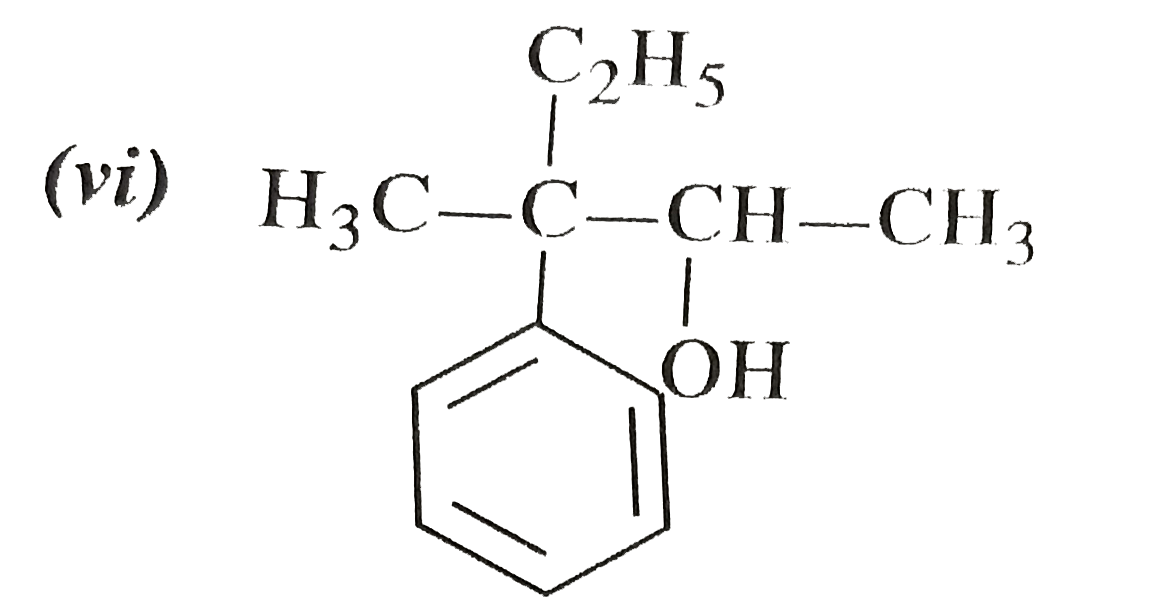Label the hydrophilic and hydrophobic parts in the following compounds.
i)CH3(CH2)10CH2OSO−3Na+
ii)CH3(CH2)15N+(CH3)3Br−
iii) CH3(CH2)16COO(CH2CH−(2)O)nCH2CH2OHSolution in Telugu
Step by step video & image solution for Label the hydrophilic and hydrophobic parts in the following compounds. i)CH_(3)(CH_(2))_(10)CH_(2) OSO_(3)^(-)Na^(+) ii)CH_(3)(CH_(2))_(15)N^(+)(CH_(3))_(3)Br^(-) iii) CH_(3)(CH_(2))_(16)COO (CH_(2)CH-(2)O)_(n) CH_(2) CH_(2) OH by Chemistry experts to help you in doubts & scoring excellent marks in Class 12 exams.
Updated on:21/07/2023Topper's Solved these Questions
- CHEMISTRY IN EVERYDAY LIFEBOOK - NCERT TELUGUCHAPTER - CHEMISTRY IN EVERYDAY LIFEEXERCISE - Exercises
27 Videos
- CHEMISTRY IN ACTIONBOOK - NCERT TELUGUCHAPTER - CHEMISTRY IN ACTIONEXERCISE - SELF EVALUATION((C) Answer not exceeding sixty words :)
2 Videos
- COORDINATION COMPOUNDSBOOK - NCERT TELUGUCHAPTER - COORDINATION COMPOUNDSEXERCISE - Exercises
32 Videos
Similar Questions
Why do we need to classify the drug in different ways?
View SolutionWrite briefly on antibiotics ? In what way antipasmodics are helpful ?
View SolutionExplain the bonding in coordination compounds in terms of Werner’s postulates.
View SolutionLabel the hydrophilic and hydrophobic parts in the following compounds. (i) CH_(3)(CH_(2))_(10)CH_(2)Osoverset(-)(O_(3))overset(+)(Na) (ii) CH_(3)(CH_(2))_(15)overset(+)(N)(CH_(3))_(3)overset(-)(Br) (iii) CH_(3)(CH_(2))_(16)COO(CH_(2)CH_(2)O)_(n)CH_(2)CH_(2)OH
View SolutionGive the IUPAC names of the following compounds:
(i)C6H5−CH2−CH2−OH (ii)CH3−CH3∣C∣CH3−CH2−CH2−OH
(iii)[(CH3)2CH]3COH. (iv)CH3−CH∣OH−CH2−CH2−O−CH2CH3
(v)CH3−CH2−CH∣Cl−CH∣CH3−CH3∣C∣OH−CH3 (vi)
(vii)(CH3)3COH (viii)CH3−CH∣CH3−CH∣OH−CH2−CH∣CH3−CH3
(ix) CH2OH |CH2−CH2−CH−CH−CH−CH3 | | CH2Cl CH3, (x) CH3−C=C−CH2OH | | CH3Br
(xi) CH2=CH−CH∣OH−CH2−CH3, (xii) CH2OH |CH3−CH−CH2−CH−CH−CH3 | | CH3 OH
View SolutionI. CH3−CH2−CH2−CH2−OH
II. CH3−CH2−CH∣OH−CH3
III. CH3−CH3∣C∣OH−CH3
IV. CH3−CH∣CH3−CH2−OH
V. CH3−CH2−O−CH2−CH3
VI. CH3−O−CH2−CH2−CH3
VII. CH3−O−CH∣CH3−CH3
Which of the above compounds form pairs of metamers ?
View SolutionI. CH3−CH2−CH2−CH2−OH
II. CH3−CH2−CH∣OH−CH3
III. CH3−CH3∣C∣OH−CH3
IV. CH3−CH∣CH3−CH2−OH
V. CH3−CH2−O−CH2−CH3
VI. CH3−O−CH2−CH2−CH3
VII. CH3−O−CH∣CH3−CH3
Identify the pairs of compounds which are functional group isomers
View SolutionI. CH3−CH2−CH2−CH2−OH
II. CH3−CH2−CH∣OH−CH3
III. CH3−CH3∣C∣OH−CH3
IV. CH3−CH∣CH3−CH2−OH
V. CH3−CH2−O−CH2−CH3
VI. CH3−O−CH2−CH2−CH3
VII. CH3−O−CH∣CH3−CH3
Identify the pairs of compounds that represents position isomerism.
View SolutionI. CH_(3) - CH_(2) - CH_(2) - CH_(2) - OH II. CH_(3) - CH_(2) - underset(OH)underset(|)(CH) - CH_(3) III. CH_(3) - underset(OH) underset(|)overset(CH_(3))overset(|)(C) - CH_(3) IV. CH_(3) - underset(CH_(3))underset(|)(CH) - CH_(2) - OH V. CH_(3) - CH_(2) - O - CH_(2) - CH_(3) VI. CH_(3) - O - CH_(2) - CH_(2) - CH_(3) VII. CH_(3) - O - underset(CH_(3))underset(|)(CH) - CH_(3) Identify the pair of compounds that represents chain isomerism
View SolutionArrange the following compounds in increasing order of S_(N^(1)) reactivity. (a). (I). ClCH_(2)CH=CHCH_(2)CH_(3) , (II). CH_(3)C(Cl)=CHCH_(2)CH_(3) , (III). CH_(3)CH=CHCH_(2)CH_(2)Cl (b). (I). CH_(3)CH_(2)Br , (II). CH_(2)=CHCH(Br)CH_(3) , (III). CH_(2)=CHBr, (IV). CH_(3)CH(Br)CH_(3) (c). (I). (CH_(3))_(3)CBr , (II). (CH_(3))_(2)CHBr , (III). CH_(3)CH_(2)CH_(2)Br ,
View SolutionPredict all order of reactivity of the following compounds in dehydrohalogenation. a,. I. CH_(3)CH_(2)CH_(2)CH_(2)Cl II. (CH_(3))_(2)CHCH_(2)Cl III. (CH_(3))_(2)CH - CH_(2)Br IV. CH_(3)CH(Br)CH_(2)CH_(3) V. (CH_(3))_(3) C - Br b. I. CH_(3)CH(Br)CH_(3) II. CH_(3)CH_(2)CH_(2)Br III. (CH_(3))_(2) CH - CH_(2) Br IV. (CH_(3))_(3)C - CH_(2) Br
View Solutionनिम्न यौगिकों में जल स्नेही तथा जल विरोधी भागों को चिन्हित कीजिए।
CH3(CH2)10CH2OSO−3Na+
(ii) CH3(CH2)15N+(CH3)3Br−
(iii) CH3(CH2)16COO(CH2CH2O)nCH2CH2OH
View SolutionLabel the hydrophilic and hydrophobic parts in the following compounds. i) CH_(3)(CH_(2))_(10)CH_(2) OSO_(3)^(-)Na^(+) ii) CH_(3)(CH_(2))_(15)N^(+)(CH_(3))_(3)Br^(-) iii) CH_(3)(CH_(2))_(16)COO (CH_(2)CH-(2)O)_(n) CH_(2) CH_(2) OH
View Solutionनिम्नलिखित यौगिकों में जलरागि एवं जलविरागि भाग दर्शाइए |
(a) CH3(CH2)10CH2OSO3Na+,
(b) CH3(CH2)15−+N(CH3)3Br−
( c ) CH3(CH2)16COO(CH2CH2O)nCH2CH2OH
View SolutionLabel the hydrophilic and hydrophobic parts in the following compounds :
(i) CH3(CH2)10CH2OSO−3Na+
(ii) CH3(CH2)15−+N(CH3)3Br−
(iii) CH3(CH2)16COO(CH2CH2O)nCH2CH2OH
View SolutionLabel the hydrophilic and hydrophobic parts in the following compounds. (i) CH_(3)(CH_(2))_(10)CH_(2)Osoverset(-)(O_(3))overset(+)(Na) (ii) CH_(3)(CH_(2))_(15)overset(+)(N)(CH_(3))_(3)overset(-)(Br) (iii) CH_(3)(CH_(2))_(16)COO(CH_(2)CH_(2)O)_(n)CH_(2)CH_(2)OH
View Solution
